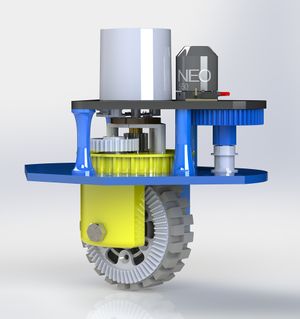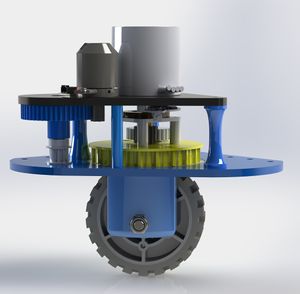Difference between revisions of "DEWBOT XVII Drive Train"
MaiKangWei (talk | contribs) (→Drive Transmission) |
MaiKangWei (talk | contribs) (→Drive Transmission) |
||
| Line 21: | Line 21: | ||
Overall drive reduction is 7.73:1. | Overall drive reduction is 7.73:1. | ||
| + | |||
| + | Overall reduction can be varied by changing the 1<sup>st</sup> stage gears (maintaining a 44 tooth count for the sum of the gears). For example: | ||
| + | * 14T:30T for 8.57 reduction | ||
| + | * 15T:29T for 7.73 reduction | ||
| + | * 16T:28T for 7.00 reduction | ||
| + | * 18T:26T for 5.78 reduction | ||
==Steering Transmission & Sensing== | ==Steering Transmission & Sensing== | ||
Revision as of 20:17, 17 February 2022
Sab-BOT-age's 2022 swerve design was developed from the back-to-the drawing-board 2020 design, with the incorporation of some significant improvements.- ) The drive transmission was simplified and reduced to 2-stages by relocating the NEO axis to the swerve rotational axis.
- ) For the first time, the steering angle is measured directly rather than by proxy.
- ) The module is now frame-corner mounted.
CVT swerve, first employed in DEWBOT XIII and used through DEWBOT XVI, was not employed.
Access zipped 2022 swerve module SolidWorks files.
Contents
Power Plants
A NEO powers the drive. Steering power provided by a NEO 550.
Drive Transmission
The drive transmission was simplified to 2 stages with a fixed gear ratio. To accomplish this, the NEO had to be relocated to make it coaxial with the rotating elements. There's no pinion. The 2022 transmission comprised:
- ) A 15T spur gear driving a 29T spur gear - 2.5:1 reduction. Both gears are steel - 1.93:1 reduction.
- ) A 15T bevel gear driving a 60T bevel gear bolted to a 4" diameter wheel. Also both steel - 4:1 reduction.
Overall drive reduction is 7.73:1.
Overall reduction can be varied by changing the 1st stage gears (maintaining a 44 tooth count for the sum of the gears). For example:
- 14T:30T for 8.57 reduction
- 15T:29T for 7.73 reduction
- 16T:28T for 7.00 reduction
- 18T:26T for 5.78 reduction
Steering Transmission & Sensing
Steering is reduced 43.6:1 in 2 stages:
- ) A 6T Pinion drives a 48T spur gear (20 DP; 14° contact angle). The pinion is steel, while the 48T gear is printed PETG.
- ) Synchronous pulley (HTD5) reduction 11:60
Focus is on minimizing steering backlash.
Steering angle is measured off the intermediate shaft, which is geared 11:60 to the Hall-Effect angle sensor. This 11:60 angle measurement reduction is separate and independent from the 11:60 steering reduction. Separate but equivalent. This is a little awkward but works.
Structural Changes
In previous 1640 pivots, rotational support was provided by a pair of 1" bearings on 2" spacing. Drive transmission passed through the 1" tube supported by these bearings, and hence to the wheel. The new design replaces this with a single 3½ inch x-cross bearing. The design relies upon a single large radius bearing on a single plane which is much closer to the load point (the floor) to maintain rotational axis integrity.
Drive power is transmitted through this larger diameter rotating element via an off-axis bevel gear. No more miter gears, transfer axle and chain. Eliminating this rotational axis reduces height.
The bottom plate, which bears the weight of the robot and shock loads, is ¼" G10 fiberglass composite. The top plate still exists but no longer plays a structural role. Rotational elements are printed from PETG (polyethylene terephthalate glycol-modified). Wheel stanchions are re-enforced with a pair of screws threaded through top to bottom on either side of the wheel axis (basically rebar for the PETG).
Important Note: Driving the wheel via bevel gears requires very accurate and consistent wheel registry on the axle. No axial slop can be tolerated. Spacers must be installed to hold the wheel in the right position.



